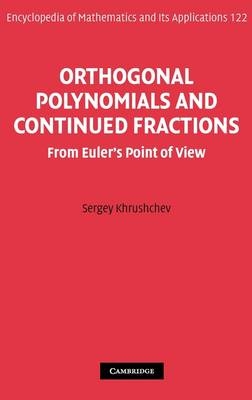
Orthogonal Polynomials and Continued Fractions
From Euler's Point of View
Seiten
2008
Cambridge University Press (Verlag)
978-0-521-85419-1 (ISBN)
Cambridge University Press (Verlag)
978-0-521-85419-1 (ISBN)
This book tells how continued fractions, studied even in Ancient Greece, only became a powerful tool in the hands of Euler, how he introduced the idea of orthogonal polynomials and combined the two subjects. The approach of Wallis, Brouncker and Euler is revived to illustrate its continuing significance on mathematics today.
Continued fractions, studied since Ancient Greece, only became a powerful tool in the eighteenth century, in the hands of the great mathematician Euler. This book tells how Euler introduced the idea of orthogonal polynomials and combined the two subjects, and how Brouncker's formula of 1655 can be derived from Euler's efforts in Special Functions and Orthogonal Polynomials. The most interesting applications of this work are discussed, including the great Markoff's Theorem on the Lagrange spectrum, Abel's Theorem on integration in finite terms, Chebyshev's Theory of Orthogonal Polynomials, and very recent advances in Orthogonal Polynomials on the unit circle. As continued fractions become more important again, in part due to their use in finding algorithms in approximation theory, this timely book revives the approach of Wallis, Brouncker and Euler and illustrates the continuing significance of their influence. A translation of Euler's famous paper 'Continued Fractions, Observation' is included as an Addendum.
Continued fractions, studied since Ancient Greece, only became a powerful tool in the eighteenth century, in the hands of the great mathematician Euler. This book tells how Euler introduced the idea of orthogonal polynomials and combined the two subjects, and how Brouncker's formula of 1655 can be derived from Euler's efforts in Special Functions and Orthogonal Polynomials. The most interesting applications of this work are discussed, including the great Markoff's Theorem on the Lagrange spectrum, Abel's Theorem on integration in finite terms, Chebyshev's Theory of Orthogonal Polynomials, and very recent advances in Orthogonal Polynomials on the unit circle. As continued fractions become more important again, in part due to their use in finding algorithms in approximation theory, this timely book revives the approach of Wallis, Brouncker and Euler and illustrates the continuing significance of their influence. A translation of Euler's famous paper 'Continued Fractions, Observation' is included as an Addendum.
Sergey Khrushchev is a Professor in the Department of Mathematics at Atilim University, Turkey.
Preface; 1. Continued fractions: real numbers; 2. Continued fractions: Algebra; 3. Continued fractions: Analysis; 4. Continued fractions: Euler; 5. Continued fractions: Euler's Influence; 6. P-fractions; 7. Orthogonal polynomials; 8. Orthogonal polynomials on the unite circle; A1. Continued fractions, Observations; Bibliography; Index.
| Erscheint lt. Verlag | 24.7.2008 |
|---|---|
| Reihe/Serie | Encyclopedia of Mathematics and its Applications |
| Zusatzinfo | Worked examples or Exercises; 12 Line drawings, unspecified |
| Verlagsort | Cambridge |
| Sprache | englisch |
| Maße | 163 x 241 mm |
| Gewicht | 860 g |
| Themenwelt | Mathematik / Informatik ► Mathematik ► Analysis |
| Mathematik / Informatik ► Mathematik ► Arithmetik / Zahlentheorie | |
| ISBN-10 | 0-521-85419-9 / 0521854199 |
| ISBN-13 | 978-0-521-85419-1 / 9780521854191 |
| Zustand | Neuware |
| Haben Sie eine Frage zum Produkt? |
Mehr entdecken
aus dem Bereich
aus dem Bereich
Buch | Softcover (2024)
De Gruyter Oldenbourg (Verlag)
CHF 83,90


